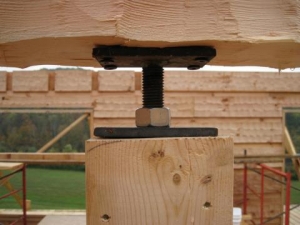Q: Will my log home settle?
 A: Yes. This is a question we are asked by many customers. While the quick answer is “yes,” this doesn’t give the entire picture.
A: Yes. This is a question we are asked by many customers. While the quick answer is “yes,” this doesn’t give the entire picture.
First, let’s define what settling is. According to the National Association of Certified Home Inspectors (NACHI), “settling is the term that describes the loss of wall height (when speaking of wood framing or log framing) over time. The principal causes of settling are:
1) shrinkage of log diameter to an in-service condition (loss of water), and
2) compression of wood fibers under the load of the building.”
This sounds simple enough, but do a quick web search for “log home settling” and you will note that many people have very different ideas on what settling is, whether it even exists (note, we equate these people with the “Flat Earthers” and advise you slowly back out of the area if you hear this), and how it should be handled.
 Wood expands and contracts according to its environment. If you live in a very humid area, like our mill and offices in East Tennessee, at the base the Smoky Mountains (a national rainforest by the way), wood will have a higher moisture content than Arizona, for example. So, no matter how much air drying you do here in Tennessee, if the home is being shipped to another location, chances are the area will have more or less humidity on average. This also depends on the time of year, conditions of the transport, etc.
Wood expands and contracts according to its environment. If you live in a very humid area, like our mill and offices in East Tennessee, at the base the Smoky Mountains (a national rainforest by the way), wood will have a higher moisture content than Arizona, for example. So, no matter how much air drying you do here in Tennessee, if the home is being shipped to another location, chances are the area will have more or less humidity on average. This also depends on the time of year, conditions of the transport, etc.
It is a common misconception that logs are dried in a kiln simply for speed of preparation and because of what we call the “greed factor.” Simply put, the “greed factor” means more product in, more product out. There is a good reason kiln drying has become the de facto standard in proper log home preparation. Trust us, it would be much cheaper to just let them air dry in a larger, more open location, but that wouldn’t be the best way. By kiln drying the logs, not only are you taking the moisture content out, but you are also preparing the log to be at the lowest moisture level possible. This is very important if your area goes through a dry season with very high heat. The last thing you want is your log diameter changing beyond its prepared limits. This can result in bad splits or checks in the log system.
 All log homes (in fact, all wood products) will settle or compress over time. Whether your home is built in hardwood or softwood, it will settle to some degree. Settlement can also be affected by the time of year the logs were cut, home construction methods, the humidity both inside and outside the home, and the type of heating and cooling used in the home. The best way to approach settling is to look at it as a basic characteristic of all wood products; not as a problem to be dealt with, but something to be understood, respected, and expected.
All log homes (in fact, all wood products) will settle or compress over time. Whether your home is built in hardwood or softwood, it will settle to some degree. Settlement can also be affected by the time of year the logs were cut, home construction methods, the humidity both inside and outside the home, and the type of heating and cooling used in the home. The best way to approach settling is to look at it as a basic characteristic of all wood products; not as a problem to be dealt with, but something to be understood, respected, and expected.
It is very important that you choose a contractor and a log home manufacturer who allow for settling. If you come across a builder who boasts that his houses don’t settle, run the other way and look for someone who understands log homes. Even if the logs are properly dried, if something introduces moisture to the inside of the home (say, for instance, a tenant of your rental home leaves the bathtub on and soaks the entire floor), the logs will then need to re-dry, which could cause problems if proper adjustment techniques are not utilized.
A great place to look for problem areas, and to check for the occurrence of settling, is around the windows and doors. If the logs are being held up by the windows, you have a problem. Assuming your contractor installed adjustment jacks, a quick adjustment will cure the issues. If not, well… it takes a bit more work to install these items after the fact.
Builders and log home companies alike have many methods they employ to accommodate settling.
- Vertical posts with adjustments are used to support homes’ second levels and roof systems. If the home should require adjustment, a simple turn from the screw assembly will be all that is needed in most cases. Typically, if you see problems in this area, they will occur once the home has had a complete cycle through all of the seasons of the year.
- Screw jack assemblies are also often used in areas where no posts are visible. These are located within interior framed walls and can be lowered as the log walls settle. This lowers the center of the second floor system, keeping it aligned with the log wall.
- Windows and doors must be considered, also. Most companies include settlement spaces above doors and windows. These spaces are filled with batt insulation, and the logs are then allowed to settle around the door or window opening through the use of “T-jambs,” that allow for the logs to move without causing issues to the windows or doors. Window and door framings are attached to log walls by nails or screws that are driven through a slot in the framing. Trim is attached in such a way that it will not prevent the log from moving. As settlement occurs, the nails or screws simply slide down the slot, preventing gaps from appearing. Again, most of the time the adjuster isn’t needed, but it is easier to prepare for things ahead of time, versus needing adjustment and not having a way to accommodate later.
There are areas where signs of settling are most evident in improperly constructed log homes:
- The stairs may be out of alignment, or feel like you are stepping down or up at the top landing.
- Windows and doors might be out of adjustment, hard to operate, or even shatter from the weight of the logs resting on them.
- Gaps may occur between the log wall and roof of a full log wall system.
- Cracks between the log courses may be visible.
- The center girder beam might be higher than the outside of the second floor. This is an area where the adjustment would need to be let down to allow for log shrinkage.
Settling only becomes a problem when the contractor or subcontractor fails to recognize or respect it. Make certain your contractor has experience building log homes. Look at homes he or she has built, paying close attention to signs of settling. Ask how settling will be accommodated. While settling is a common characteristic in log homes, it must be understood and accounted for, or you will have problems in the future.


